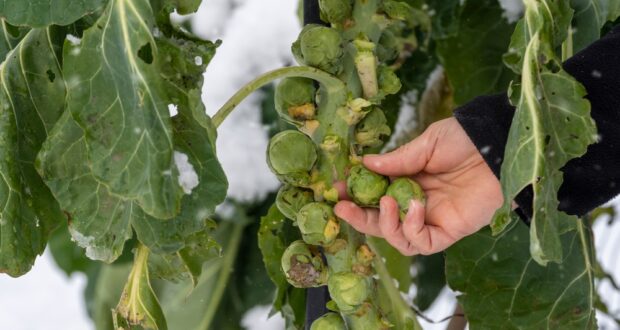Blog
Expanding collections to with winter winter gardening strategies
Experienced gardeners often see the winter as a time of rest for their gardens, the season in which nature is deserved. But thanks to the right tools and techniques, winter can become an extension of the growing season, bringing a prize of fresh, aromatic products even in the most difficult climates. Winter gardening, focusing on cold crops, unheated greenhouses and strategic planning, is an exciting challenge for experienced gardeners who want to cross the boundaries of traditional cultivation.
The matter of winter gardening
Winter gardening is more than new; This is a practical solution to maintain continuous supply of fresh vegetables while reducing relying on stored or imported products. For many, the appeal lies in the possibility of cultivation of a peak flavor. Many cold vegetables, such as spinach, carrots and mâche, become sweeter and more delicate when grown at cooler temperatures, thanks to the natural concentration of sugar, which occurs as a defense against the cold.
For experienced gardeners, winter gardening also allows them to improve their skills and experiment with innovative techniques that can revolutionize their approach to year -round production.
Key rules of the blooming winter garden
1. Choice of cold crops Vegetables are the spine of winter gardening. These crops can withstand freezing temperatures and continue to grow, although slower, in shorter days. The joint elections include:
- Deciduous green: spinach, kale, rocket and mâche.
- Root vegetables: carrots, parsnip and radish.
- Brassicas: Broccoli Raab, Kohlrabi and Collards.
These plants survive cold and often bloom in winter conditions, ensuring a unique taste and nutrition.
2. Planting success and time
The success in winter gardening depends on the planting schedules that correspond to more slowly. Unlike spring planting, in which the length of the day increases, winter crops must be sown early enough in autumn to determine before the “Persephone period” when the daylight drops below 10 hours. In many regions this happens from mid -November to the end of January. By planting in late summer until early autumn, gardeners can ensure that crops are almost mature depending on winter sets, ready for permanent harvest for cooler months.
Winter garden covered with a greenhouse, high tunnel or cold frame … Simple structures that protect crops against frost, wind and snow, while providing stable, cold harvest.
3. Protection Cultivation
For most climates, vegetable cultivation in winter requires a form of protection. Experienced gardeners often turn to unheated greenhouses, high tunnels or cold frames. These structures buffed on difficult conditions, moderated and crops protecting against wind and snow.
Advanced practitioners can use two -layer systems, combining the outer cover of the greenhouse with internal floating covers. This double approach creates a microclimate in which durable vegetables can develop, even when external temperatures fall below zero.
4. Giving and fertility management
Healthy soil is the basis of any productive garden, and winter gardening is no exception. While the growing season can be extended, soil health should remain a priority. Techniques such as minimal cultivation, regular adding compost and strategic crop rotation are necessary to maintain fertility and structure.
Many experienced gardeners also use green manure or cover crops in the period out of season in parts of their garden, which have not been designated for winter production. These crops enrich the soil, prevent erosion and support the life of microorganisms, preparing a stage of solid growth in the following seasons.
5. Mobility of the greenhouse
For people with resources, greenhouses offer an advanced solution for the rotation of crops and challenges related to soil health. These structures can be moved between the cultivation areas, enabling natural soil recovery by exposure to elements and pruning. This practice reduces the accumulation of pests and diseases, providing healthier and more resistant crops.
Solving problems of typical challenges
Winter gardening is not without obstacles, even for an experienced breeder. Pest control requires vigilance, especially for insects such as aphids that develop in protected environments. Regular monitoring of crops and the use of integrated pests management strategies can alleviate infestations.
The length of the day is another factor that slows down growth in the heart of winter. To counteract this, experienced gardeners stop planting dates and focus on crops that can stay in the field without losing quality. For example, spinach and mâche can be collected in a few weeks, providing a constant supply.
Benefits outside the harvest
Winter gardening offers more than just fresh products. It expands the joy of gardening to cooler months, ensuring a significant relationship with the earth when the world of nature seems dormant. It also promotes immunity and sustainable development, reducing relying on energy -consuming methods, such as heated greenhouses or imported food.
Practice is a satisfactory challenge for experienced gardeners who test ingenuity and deepens their understanding of seasonal cycles. Transforms winter from a period of deficiency into abundance and possibility.
Final thoughts
Winter gardening is not for people with a weak heart, but for an experienced gardener he offers a mature limit for exploration. By using the synergy of cold crops, planting succession and protected cultivation, you can redefine, which means for the garden throughout the year. With thoughtful preparation and readiness to experiment, your winter garden can become a testimony to nature immunity and mastery of craftsmanship.

